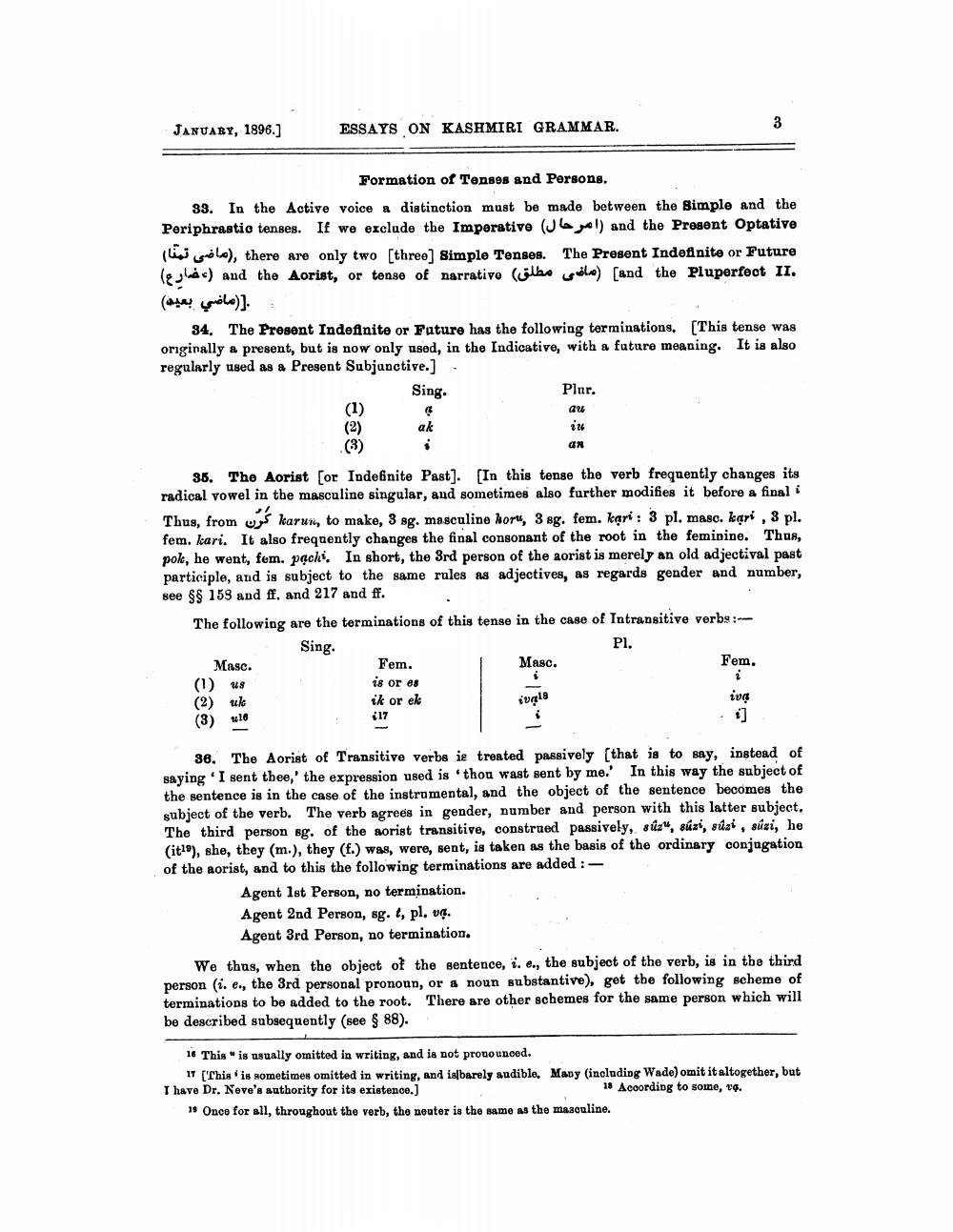Book Title: Indian Antiquary Vol 25 Author(s): Richard Carnac Temple Publisher: Swati Publications View full book textPage 7
________________ JANUARY, 1896.) ESSAYS ON KASHMIRI GRAMMAR. Formation of Tenses and Persons. 33. In the Active voice a distinction must be made between the simple and the Periphrastio tenses. If we exclude the Imperativo (Jag) and the Present Optative Ili Wile), there are only two [three) Simple Tenses. The Present Indefinite or Future lejles) and the Aorist, or tense of narrative (cibe col) (and the pluperfect II. ( Comile)]. 34. The Present Indefinite or Future has the following terminations. [This tense was originally a present, but is now only used, in the Indicative, with a future meaning. It is also regularly used as a Present Subjunctive.] . Sing Plnr. (1) Qu ir 35. The Aorist (or Indefinite Past]. (In this tense the verb frequently changes its radical vowel in the masculine singular, and sometimes also further modifies it before a finali Thus, from wes karun, to make, 3 sg. masculine horu, 3 sg. fem. kari: 3 pl. maso. kari , 3 pl. fem. kari. It also frequently changes the final consonant of the root in the feminine. Thus, pok, he went, fem. pachi. In short, the 3rd person of the aorist is merely an old adjectival past participle, and is subject to the same rules as adjectives, as regards gender and number, see $$ 159 and ff, and 217 and ff. The following are the terminations of this tense in the case of Intransitive verbs Sing PI. Masc. Fem. Masc. Fem. (1) 18 is or es (2) uk ik or ek iva (3) 16 117 ivale 36. The Aorist of Transitive verbs ie treated passively (that is to say, instead of saying I sent thee,' the expression used is thou wast sent by me.' In this way the subject of the sentence is in the case of the instrumental, and the object of the sentence becomes the subject of the verb. The verb agrees in gender, number and person with this latter subject. The third person sg. of the aorist transitive, construed passively, súzu, súzi, súzi, súzi, he (it), she, they (m.), they (f.) was, were, sent, is taken as the basis of the ordinary conjugation of the aorist, and to this the following terminations are added : Agent lst Person, no termination. Agent 2nd Person, sg. t, pl. vg. Agent 3rd Person, no termination. We thus, when the object of the sentence, i. e., the subject of the verb, is in the third person (i. e., the 3rd personal pronoun, or a noun substantive), get the following scheme of terminations to be added to the root. There are other schemes for the same person which will be described subsequently (see & 88). 16 This is usually omitted in writing, and is not pronounced. IT (This is sometimes omitted in writing, and is barely audible. Mady (including Wade) omit it altogether, but I have Dr. Neve's authority for its existence.) 18 According to some, ve. 19 Once for all, throughout the verb, the neuter is the same as the masculino.Page Navigation
1 ... 5 6 7 8 9 10 11 12 13 14 15 16 17 18 19 20 21 22 23 24 25 26 27 28 29 30 31 32 33 34 35 36 37 38 39 40 41 42 43 44 45 46 47 48 49 50 51 52 53 54 55 56 57 58 59 60 61 62 63 64 65 66 67 68 69 70 71 72 ... 366
